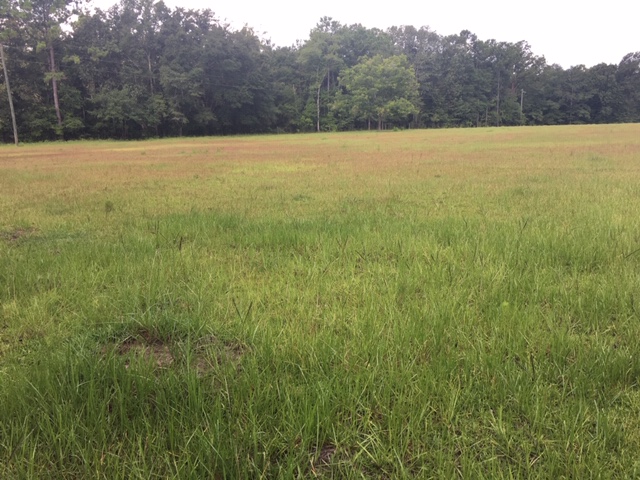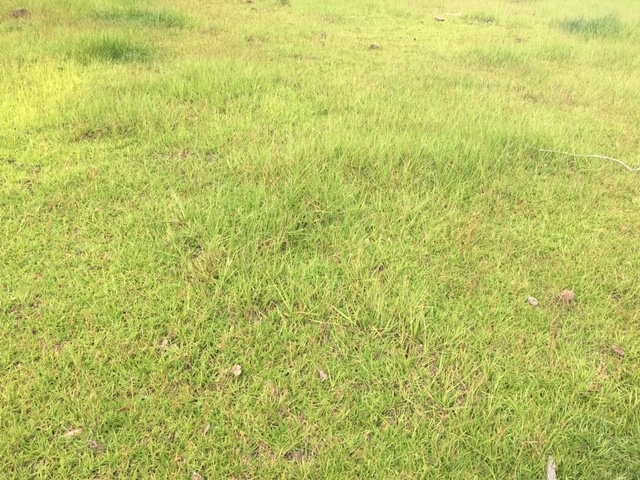
Centipede Grass infested Bahiagrass Pasture in Gadsden County Photo Credit : Shep Eubanks – UF/IFAS Gadsden County Extension
Encroachment of centipede grass even to the point of taking over a field of once vigorous bahiagrass or bermudagrass is an all too common occurrence. Each year extension agents receive calls to look at and help landowners rectify a situation similar to the one in the photo above. It is a distressing problem that unfortunately does not have an easy, quick fix. Most forage producers are well aware that centipede grass has no redeeming qualities as a livestock forage
Under normal growing conditions, healthy stands of perennial summer grasses such as bahiagrass and bermudagrass are not likely to be out competed by centipede grass. Almost always, producers have overgrazed their pasture, fertility is low, or both factors are involved. Over the last several years of tight margins, many cattle producers have been tempted to reduce production costs by cutting corners and not supplying adequate soil fertility. In the pasture pictured below, soil levels of phosphorus were extremely low and potassium levels were also low. However, the pH was adequate at 5.8. If the infestation has progressed to more than just isolated spots in a field, the only recourse may be to consider renovation of the field. There are not any registered herbicides that can adequately control the centipede grass without harming the forage grasses, so it is an all or nothing scenario.

Photo 1. Almost complete infestation of Centipede grass due to overgrazing and very low soil phosphorus and potassium . Photo Credit – Shep Eubanks UF/IFAS Gadsden County Extension
The following is a general prescription for renovating a pasture like the one highlighted in this article:
Weed eradication (May)
- Apply 3-4 quarts per acre of 41% glyphosate at 3-4 qt/ac rate.
- Include 2.5 gal (liquid) or 8.5 lb (dry) ammonium sulfate (AMS) per 100 gal tank.
- Do not apply if soil is dry (herbicide effectiveness is reduced).
- If there are other mature cool-season weeds in the pasture, along with the centipede, you may want to mow the pasture first, and then spray with roundup 7-10 days later when the weeds are in the vegetative state.
Soil preparation (late May/early June)
- Till herbicide-treated soil (wait until the grass is completely dead)
- Soil sample (composite multiple soil samples, using random zig-zag pattern across pasture and 6 inch depth). Negate sampling loafing, watering or feeding areas.
- Request soil pH and plant essential nutrients analysis. You can also request organic matter (OM), if you want to track OM changes over time.
- Apply lime (if soil pH below 6.0). Follow soil report liming rate recommendation.
- You may need to retreat tilled land with glyphosate, if weeds return before seeding (wait a day or two prior to seeding).
Seeding pasture (early June, when rains return)
- Purchase bahiagrass seed (can be purchased immediately and stored out of the heat)
- Argentine (handles heavy grazing pressure).
- Pensacola (what some folks call ‘common bahiagrass’, lowest yielding of those listed).
- Tifton-9 (more upright, but cannot be grazed as closely as Argentine)
- Quik-Tif and Riata (both are over 30% higher yielding than Pensacola and they have early green-up, but cannot be grazed as closely as Argentine; require good management).
- Use a cultipacker or roller to firm soil surface.
- Drill bahiagrass seed (25 lb/ac) on a firm seedbed, at a depth of ¼ to ½ inch (planting too deep is a common mistake).
- Fertilize newly emerged bahiagrass (based on soil test and IFAS recommendations) when plants reach 3-4 inches of initial growth (30 lbs N/ac initially, 50% of K2O requirement and all the P2O5 requirement).
Pasture Management (1st season)
- Apply 50 lbs N/ac and the second half of K2O requirement at about 6 weeks post-emergence (canopy at least 4 inches tall)
- Mow (maybe every 3 to 4 weeks, if needed) to combat weeds, until bahiagrass growth comes on strong (perhaps 6 to 8 weeks post emergence).
- Do not apply any herbicides for the first several weeks (until at least 8 inches tall)
- 2,4-D amine and similar can help against broadleaf weeds.
- Consult with your local Extension Agent for weed control recommendations, as needed.
- Avoid herbicide applications whenever soils are dry (low rainfall periods)
- Do not apply any herbicides for the first several weeks (until at least 8 inches tall)
- Light grazing can begin near the end of the season (late August/Sept) when the root system is developed enough to withstand grazing.
- Wild Turkey Biology and Habitat Management - March 20, 2020
- Pond Weed Control – Common Salvinia - October 11, 2019
- Renovating Centipede Grass Infested Pastures - April 26, 2019
